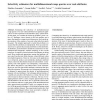Free Online Productivity Tools
i2Speak
i2Symbol
i2OCR
iTex2Img
iWeb2Print
iWeb2Shot
i2Type
iPdf2Split
iPdf2Merge
i2Bopomofo
i2Arabic
i2Style
i2Image
i2PDF
iLatex2Rtf
Sci2ools
178
click to vote
VLDB
2005
ACM
2005
ACM
Selectivity estimators for multidimensional range queries over real attributes
Estimating the selectivity of multidimensional range queries over real valued attributes has significant applications in data exploration and database query optimization. In this paper, we consider the following problem: given a table of d attributes whose domain is the real numbers and a query that specifies a range in each dimension, find a good approximation of the number of records in the table that satisfy the query. The simplest approach to tackle this problem is to assume that the attributes are independent. More accurate estimators try to capture the joint data distribution of the attributes. In databases, such estimators include the construction of multidimensional histograms, random sampling, or the wavelet transform. In statistics, kernel estimation techniques are being used. Many traditional approaches assume that attribute values come from discrete, finite domains, where different values have high frequencies. However, for many novel applications (as in temporal, spatial, ...
Database | Kernel Density Estimators | Multidimensional Query Approximation | Real Valued Attributes | VLDB 2005 |
Related Content
| Added | 05 Dec 2009 |
| Updated | 05 Dec 2009 |
| Type | Conference |
| Year | 2005 |
| Where | VLDB |
| Authors | Dimitrios Gunopulos, George Kollios, Vassilis J. Tsotras, Carlotta Domeniconi |
Comments (0)

